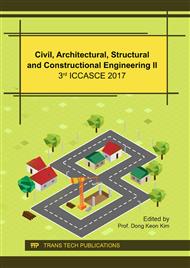[1]
A. A. Kuzmichev, V. F. Loboyko. Impact of polluted air on the appearance of buildings and architectural monuments in the area of town planning. Proc. Eng. 150 (2016) 2095-2101.
DOI: 10.1016/j.proeng.2016.07.244
Google Scholar
[2]
V. N. Azarov, N. V. Menzelintseva et al. Main Trends of Conditions Normalizing at Cement Manufacturing Plants. Int. Rev. Civil Eng. 6(6) (2015) 145-150.
Google Scholar
[3]
V. Kucera, S. Fitz. Direct and indirect air pollution effects on materials including cultural monuments. Water, Air and Soil Pollut. 85(1) (1995) 153-165.
DOI: 10.1007/bf00483697
Google Scholar
[4]
V. N. Azarov, A. A. Kuzmichev. Pollution of building constructions and architectural manuments as one of the aspects of visual ecology. Soc. City, 2 (2015) 76-86.
Google Scholar
[5]
Air quality guidelines: global update 2005. Particulate matter, ozone, nitrogen dioxide and sulfur dioxide. Copenhagen, (2006).
Google Scholar
[6]
E. Samoli. et al. Acute effects of ambient particulate matter on mortality in Europe and North America: results from the APHENA Study. Environmental Health Perspectives, (2008).
DOI: 10.1289/ehp.11345
Google Scholar
[7]
R. Beelen. et al. Long-term effects of traffic-related air pollution on mortality in a Dutch cohort (NLCS-AIR Study). Environmental Health Perspectives, (2008).
DOI: 10.1289/ehp.10767
Google Scholar
[8]
D. Krewski. et al. Extended follow-up and spatial analysis of the American Cancer Society linking particulate air pollution and mortality. Boston, MA, Health Effects Institute, (2009).
Google Scholar
[9]
C. A. Pope III et al. Lung cancer, cardiopulmonary mortality, and long-term exposure to fine particulate air pollution, J. Am. Med. Associat. (2002).
DOI: 10.1001/jama.287.9.1132
Google Scholar
[10]
V. N. Azarov, A. A. Kuzmichev. The totality of physical and visual aspects when studying contamination of building structures and monuments of architecture. Soc. City, 3 (2016) 28-42.
Google Scholar
[11]
A. V. Gorodkov, S. I. Saltanova. Ecology of visual environment: work-book for higher education institutions. 2nd edition. Saint-Petersburg. Lan' Publ. (2013), p.192.
Google Scholar
[12]
A. A. Kuzmichev, V. N. Azarov. The study of impact of air pollution on external appearance and perception of building constructions and architectural monuments. Biosph. Compab.: Human, Region, Tech. 1(13) (2016) 86-96.
Google Scholar
[13]
Y. O. Nazim, B. L. Mikhail, O. Ivan, A. S. Natalia, A. K. Andrew, G. K. Alla. Computer - Based visual analysis of ecology influence on human mental health. 2016 7th International Conference on Information, Intelligence, Systems & Applications (IISA), IEEE Conference Publications, 2016, 1-6.
DOI: 10.1109/iisa.2016.7785416
Google Scholar
[14]
V. Azarov, N. Barikaeva, T. Solovyeva. Monitoring of Fine Particulate Air Pollution as a Factor in Urban Planning Decisions. Proc. Eng. 150 (2016) 2001–(2007).
DOI: 10.1016/j.proeng.2016.07.279
Google Scholar


